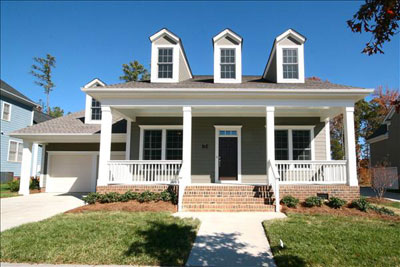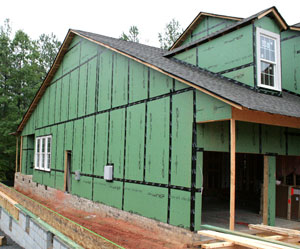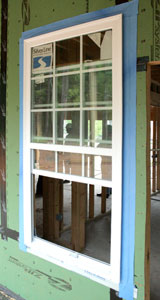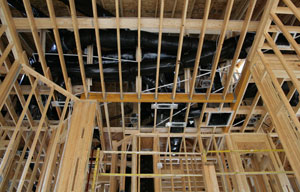Baxter Village is a residential community located approximately 20 miles south of Charlotte, North Carolina. The development is being constructed by the Charlotte division of David Weekley Homes (DWH).
Baxter Village in Fort Mill, South Carolina is located within DOE Climate Zone 3—a mixed-humid climate. A mixed-humid climate is defined as a region that receives more than 20 inches of annual precipitation, has approximately 5,400 heating degree days or less, and where the monthly average outdoor temperature drops below 45˚F during the winter months.
DWH is actively reducing the energy consumption of their homes through the implementation of their David Weekley “Green Homes” program. This program is intended to promote certain features designed to make homes more economically sustainable over the long term and reduce energy usage and the resulting environmental impact. The DWH Green Program is not only being implemented successfully in Charlotte, but nationwide in almost all DWH divisions. The Charlotte division of DWH is reducing their energy demand through a number of techniques including advanced air sealing techniques, the installation of SEER 14 air conditioners, and Low-e windows in conjunction with conventional framing and insulation. The homes built by the Charlotte division of DWH have been able to maintain a competitive market advantage in all developments even within a soft housing market.
DWH is working with Southern Energy Management for ENERGY STAR® verification and Masco implementing their Environments for Living® (EFL) program. Masco EFL is providing the majority of the testing and rating the homes. All homes are attaining the Diamond class under the EFL program. The Diamond level of EFL ensures the homes have enhanced water efficiency, advanced indoor air quality and attain an air tightness of 0.25 cfm/ft2 of envelope area at 50 pascals as well as other performance standards (www.environmentsforliving.com). The EFL program standards have been developed with the support of BSC’s Building America researchers.
The target for the DWH Fort Mill development is to achieve a 40% whole house energy savings over the BA benchmark in a mixed-humid climate. All homes built will also be part of the DWH Green Program, EFL Diamond and in 2009 they will be part of the DOE Builders Challenge.
Project Team: David Weekley Homes Charlotte, North Carolina Division, Building Science Corporation, MASCO—Environments for Living™
Address: Fort Mill, South Carolina
Description: 2,098 to 3,721 ft2 one- and two-story, 3 to 4 bedroom homes
Completion Date: To be completed 2009
Estimated Annual Energy Savings: $986 Energy savings per year
Project Website: http://tinyurl.com/bofwc6
Enclosure Design
Roof: Trussed
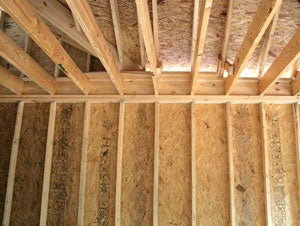
Roof trusses stacked above wall framing
Framing: 2x4 conventional wall framing at 16 o.c.
Air Sealing: Taped Huber ZIP System® sheathing; low expanding foam sealant around windows doors, penetrations and base plates
Roof Insulation: R-30 fiberglass batt insulation on flat ceilings; R-19 in sloped ceilings
Wall Insulation: R-13 fiberglass batt insulation
Drainage Plane: Taped Huber ZIP System® sheathing
Window Specifications: Double pane vinyl spectrally selective Low-E: U=0.34, SHGC=0.27
Foundation: Vented unconditioned crawlspace
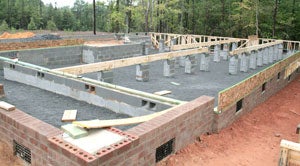
Vented, unconditioned crawlspace
Infiltration: 2.5 in2 leakage area per 100 ft2 envelope
Features:
- Very airtight construction
- Fully-flashed windows
- Continuous drainage plane
Mechanical Design
HERS Index Score: 72
Heating: 92% AFUE natural gas forced air furnace
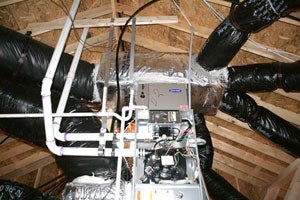
Natural gas forced air furnace
Cooling: 14 SEER
Ventilation: Honeywell supply-only integrated with AHU (CFIS)
Return Pathways: Transfer grilles at bedrooms
Ducts: R-6 flex ducts with mastic sealed joints
DHW: 0.58 EF natural gas water heater
Appliances: ENERGY STAR® dishwasher, refrigerator, clothes washer
Lighting: ENERGY STAR® CFLs
Site Generated Power: None
Water Management
DWH in Charlotte utilizes the Huber ZIP System® sheathing in conjunction with self-adhered membrane flashings as a drainage plane to ensure water than passes the primary water shedding layer is not allowed to penetrate into the building assembly. Sub-sill flashings are also provided below all windows to ensure that in the event a window leaks the water will not enter into the wall assembly. The photos within the Building Enclosure section of this report show both the fully flashed window and the taped Huber ZIP System® sheating. The quality control coaches have paid special attention to these details and have consistently achieved a high level of quality workmanship.
Quality Assurance & Quality Control
The Charlotte division has made noteworthy quality control advancements. They have implemented process and technology changes through special trade training. Examples of these changes are the water management and air tightness improvements made by their framing contractor. A single framing company was chosen, trained and then hired as a consultant to train their other framing contractors. DWH’s insulation and HVAC upgrades were completed through partnering with a single insulation company and a single HVAC company who were extensively trained and were solely used in all developments. Through this training and partnering they were able to attain consistent performance in all developments.
DWH also employs on-staff ‘quality coaches’ to train trades and perform QC spot checks. The quality coach plays an important role in setting expectations for the quality of workmanship and building performance and identify ‘slippages’ in quality as production proceeds.
A durability checklist (QC) was created to address areas where quality of work has an effect on the energy performance, indoor air quality and durability of the house. Team members then verified these items in the field to ensure they were installed or constructed as required. The following is an example portion of the checklist.
A drainage plane must be provided that is integrated with flashings
A drainage plane must be accompanied by a drainage space
Subsill flashing: windows and doors must be “pan-flashed”
|
Testing
Airtightness testing of the enclosure and ductwork was completed by Southern Energy Management. The tests completed were required to attain ENERGY STAR® and EFL Diamond certification. The following tests were performed:
- Air leakage
- Duct leakage
- Local air flows
- System external static pressure
- Outside air duct air flow
Monitoring
BSC is currently not monitoring any homes within the DWH Fort Mill community. It is anticipated during 2009 with the occupancy of the homes that BSC will collect utility use data for comparison to modeled energy consumption.
Technology Gaps and Barriers
Due to cost implications in a slow moving market there are a few energy efficiency upgrades proposed by BSC that could not be implemented in 2008.
The R-13 conditioned crawlspace option was not chosen in 2008. This would consist of sealing and insulating the crawlspace with a combination of foil faced polyisocyanurate foam and spray foam to ensure air barrier continuity. The floor would be covered and sealed with 6mil polyethylene with the joints taped to create an air seal.
Advanced framing techniques are anticipated to be included during 2009. This would require upgrading to 2x6 construction at 24” centers, stacked framing, 2-stud corners along with the removal of redundant framing members will increase the insulation value of the envelope, decrease material costs and, once training is complete, reduce construction time.
The installation of a 0.82 EF tankless hot water heater would be a relatively easy replacement that was omitted in 2008 purely on a cost basis.
Lessons Learned & Future Projects
It is anticipated that the changes discussed in the Technology Gaps and Barriers section will require trade training and additional site visits for review of QA/QC procedures. According to our whole house energy analysis, the as-built houses are modeled to achieve an energy savings of 34.2% when compared to the BA benchmark. Due to cost implications in a slowing housing market, the R-13 conditioned crawlspace, advanced framing techniques and 0.82 EF tankless hot water heating options were not implemented during 2008. These final three upgrades would allow the homes to achieve nearly a 40% savings of the BA benchmark and achieve HERS scores below 70.
It is anticipated that the next stage of upgrades may be implemented during the phases of the Fort Mill development that begin during 2009. The combination of implementing QA and process changes has allowed the integration of these changes to happen seamlessly and BSC has a high degree of confidence in DWH’s ability to implement these additional changes.
Construction of the Baxter development will continue into 2009. The BSC assisted DWH Green program has proven successful for the Charlotte division and the construction methods developed in 2008 will continue to be implemented in 2009.

